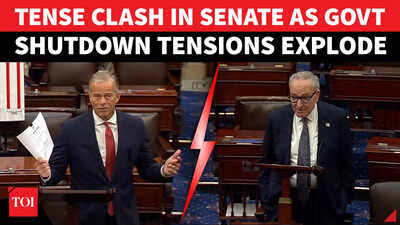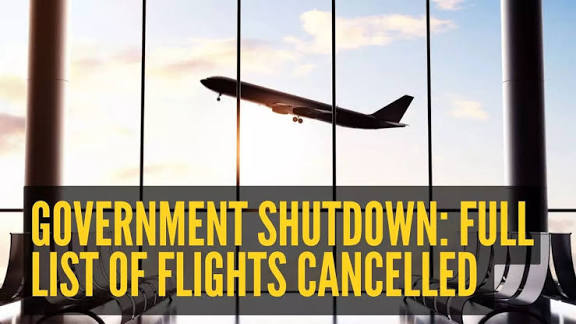John Thune’s Test: Steering the Senate Through Shutdown & Trade Turmoil

House speaker Mike Johnson and Senate majority leader John Thune is expected to hold a news conference at 11 am. Today we will discuss about John Thune’s Test: Steering the Senate Through Shutdown & Trade Turmoil
John Thune’s Test: Steering the Senate Through Shutdown & Trade Turmoil
When crisis hits Washington, the maneuvers of Senate leaders often decide whether gridlock becomes ruptured governance or stalemate. In 2025, Senator John Thune (R-SD), as Senate Majority Leader, faces twin tests: navigating a federal government shutdown and managing escalating trade tensions under a tariff regime. His leadership approach, choices of alliances, and strategic gambits may well define his legacy—and influence the balance of power in Congress.
1. Background: Thune’s Rise and the Stakes Ahead

John Thune has long been a familiar name in Senate Republican circles. Since entering the Senate in 2005, he has consistently emphasized fiscal discipline, agricultural interests (as South Dakota is a deeply rural, farm-oriented state), and Republican institutionalism.
Over time he has held important committee assignments and leadership roles, culminating in his current position as Senate Majority Leader in 2025, a perch that demands balancing intra-party pressures, coalition needs, and interbranch negotiation.
Yet the moment he faces is turbulent. On one front, the looming threat of a government shutdown looms as federal funding deadlines slip past October 1. On another, President Donald Trump’s aggressive tariff and trade policies have unsettled markets and provoked bipartisan concern. Thune must determine how far to support or restrain the executive’s trade agenda, while simultaneously shepherding legislation to reopen government and keep bipartisan coalitions intact.
These dual crises intersect: a protracted shutdown fuels economic turbulence, amplifies skepticism of leadership, and weakens leverage in broader bills such as trade or appropriations. To prevail, Thune must thread a narrow path: remain credibly in charge, avoid alienating key GOP holdouts, and extract Democratic votes to pass essential legislation.
2. The Shutdown Standoff: Strategy, Pressure, and Red Lines
2.1 Setting the Stage
By late September 2025, prospects for a smooth budget deal were fading. Republicans had passed a continuing resolution (CR) to extend funding until November 21. But Democrats insisted on tying in expansions of Affordable Care Act (ACA) subsidies and reversals of certain tax provisions. Thune and Senate GOP leaders resisted, framing the CR as clean and non-ideological — a “nonpartisan extension” to allow time for appropriations.
Thune, in public messaging and interviews, signaled unwillingness to negotiate on policy while the government remained closed. He repeatedly insisted that Democrats must first support reopening government; then broader policy deals might follow.
2.2 Calculated Gambits & Public Pressure
A key element of Thune’s calculus is psychological leverage. He is betting that Democrats and moderate senators will come under mounting pressure—politically and electorally—to accept a clean CR. The strategy: delay policy concessions until Senate Democrats fracture or moderate senators decide the optics of continued shutdown are too damaging. As he put it, when there is a “critical mass” of Democrats willing to support the CR, that becomes the moment to begin more substantive conversations.
Thune also declines to negotiate with Senate Minority Leader Chuck Schumer directly at this stage, instead focusing on rank-and-file Democrats. He views individual senators as the path to breaking deadlock rather than sweeping leadership deals.
He contends that conceding policy demands during a shutdown sets a dangerous precedent: each crisis becomes a hostage moment. He stated, “Once you start conceding to demands on shutdowns, every time we get up against a deadline, you’re going to have another shutdown.”
2.3 Risks From Within
Thune’s internal balancing act is delicate. The Senate GOP is not monolithic: ideological hardliners, fiscal hawks, and pragmatic moderates coexist. Some Republicans may chafe at any perceived weakness or delay. Others may push for more policy protections (such as ensuring ACA subsidy extensions). Thune must manage internal dissent, maintaining unity until he has enough external support to close the deal.
Furthermore, the White House plays its cards aggressively. Trump and budget director Russ Vought have threatened mass layoffs, cut or withheld funds to projects in states represented by Democratic senators, and raised the rhetorical burden on Democrats.
These moves risk hardening Democratic resistance rather than coaxing cooperation—but they also magnify urgency for a resolution.
2.4 The Mid-Shutdown Introspection
As days drag on, the cumulative cost of a shutdown becomes severe: furloughed federal workers, suspended services, delayed contracts, and adverse effects on public trust. Thune must monitor political momentum and public sentiment—if the backlash is strong, he may have to shift tactics or offer concessions earlier.
In interviews, Thune has sometimes softened rhetorical posture, saying that a shutdown is still avoidable if Democrats “dial back” demands.
He also acknowledges uncertainty: even if a deal framework is discussed post-reopening, he cannot guarantee full legislative closure then.
3. Trade Turmoil: Tariffs, Congressional Authority & Senate Dynamics
While the shutdown occupies center stage, trade policy is no backwater issue. The Trump administration’s sweeping tariffs—especially a 10% global tariff structure and reciprocal duties on 57 countries—have stirred market jitters and draw scrutiny from both parties.
3.1 Thune’s Position: Deference with Caution
As Senate Majority Leader, Thune has avoided direct confrontation with the White House on tariffs but has signaled that Congress should “let it play out.” In early April 2025, he observed that market volatility was expected and that patience is warranted to see how nations respond.
When a bipartisan Senate resolution sought to terminate the national emergency underpinning the tariffs (thus rolling them back), Thune moved to table the measure, ultimately preserving the tariff regime. That move succeeded via tie-breaking vote of Vice President J.D. Vance—after Thune ensured the resolution did not advance further.
Thus, while not aggressively championing the tariff agenda, Thune defends it from legislative derailment. He maintains that Congress should measure impact and response before intervening too aggressively.
3.2 The Tension Between Executive and Legislative Trade Powers
Thune’s leadership role requires him to manage Senate prerogatives over trade. Over time, Congress has ceded trade authority to executive agencies (e.g. via fast-track mechanisms, delegations, emergency declarations). Some senators—including across party lines—seek to reclaim oversight or require more robust legislative review.
Thune’s choice to table the resolution demonstrates reluctance to reassert such assertive oversight in this moment. He judged that proceeding before full information or political consensus would undermine GOP unity or contradict the executive’s declared power. But that position is not without critics: opponents argue he is enabling tariffs that increase costs for consumers and strain international trade relations.
3.3 Managing Intra-Party Friction & Democratic Pressure
Within the GOP, voices like Senators Susan Collins and Lisa Murkowski (both Republican moderates) crossed party lines to support the resolution rolling back tariffs. Thune had to navigate such defections or negotiations to keep the party unified. In that regard, his decision to quickly kill the resolution preemptively shows a tactical shield: prevent the measure from gaining traction before dissent crystallizes.
Conversely, Democrats argue that Thune and Senate Republicans “own” the tariff tax, particularly on working-class Americans. Schumer, for example, criticized the vote to table the resolution as evidence that Republicans accept the cost burden.
Thune must manage not only GOP cohesion but the narrative: he cannot allow trade policy to worsen public discontent or undermine his leverage in other negotiations (such as appropriations or subsidies).
4. Intersection of Shutdown & Trade: Conflict or Complement?
These two arenas are not independent. A prolonged shutdown increases economic strain, undermines investor confidence, and heightens public frustration—a risky backdrop for managing trade expectations. Markets already react to tariff announcements; layering in federal paralysis adds volatility.
Thune’s decisions in one domain affect credibility in the other. If he appears weak or inconsistent in the shutdown fight, his ability to rally support on trade or legislative oversight diminishes. Similarly, if trade backlash intensifies (say, due to retaliatory tariffs, disrupted supply chains, or voter anger over consumer prices), that pressure may leak into budget politics and fracture alliances.
In sum, Thune must calibrate: he cannot treat these issues in silos. His leadership must be coherent across the board, with messaging that frames trade stability and fiscal responsibility as part of a unified governance agenda.
5. Tactical Scenarios & Possible Outcomes
Given the stakes, several outcome scenarios loom. Here is how Thune’s choices could play out:
5.1 Swift Reopening, Conditional Concessions
If enough Democrats agree to support a clean CR (or minimal rider modifications), Thune may reopen government quickly. Then, he might craft a structured negotiation roadmap for ACA subsidies, tax changes, and trade oversight. This scenario preserves momentum and reduces economic damage. But the challenge: delivering on the promises and balancing concessions so GOP hardliners don’t rebel.
5.2 Protracted Shutdown & Political Fallout
If neither side yields and the shutdown extends into weeks or months, the burden of blame will mount. Thune may be blamed by moderates or independents for obstinacy. Public frustration could push moderate senators to defect. The longer the shutdown, the more disruptive the domestic economy and the weaker legislative bargaining positions become—including on trade. In such a scenario, Thune’s leadership credibility is at risk.
5.3 Partial Deal, Midterm Bridging
A hybrid outcome is possible: rollback of parts of the Democratic demands (e.g. temporary ACA subsidies) in exchange for reopening, while deferring contentious tax reversals or trade review to future debate. Thune must maintain a credible baseline—ensuring GOP cohesion while offering plausible pathways to compromise.
5.4 Trade Backlash Forcing Senate Reversal
If trade policy shocks intensify—due to retaliatory tariffs, consumer inflation spikes, or economic contraction—the Senate (including Republicans) may feel pressure to revisit tariff authority. In that case, Thune might be forced to entertain more assertive oversight or rollbacks, even if he initially resisted. That pivot would test his political flexibility.
6. Leadership Style & Institutional Philosophy
Thune’s approach reflects not just tactical calculation but an institutional philosophy: the Senate should avoid episodic shutdown brinksmanship, and major policy shouldn’t be bargained in crisis mode. He’s argued that major decisions should not be made in haste or under duress.
At the same time, his decision to defer trade oversight and accept executive latitude shows pragmatism and deference to executive prerogatives—at least for now. His willingness to shift if necessary (e.g. acknowledging the possibility of new conversations if enough Senators are ready) underscores a fallback flexibility.
If Thune succeeds—reopening government with minimal pain, maintaining GOP unity, and avoiding a market backlash in trade—his stature will rise. If he falters or miscalculates, intra-party rifts and public backlash could diminish his authority.
7. Public & Media Perception: Scapegoat or Strategist?
In media narratives, Thune is already walking a tightrope. Criticism arises from both sides: from Democrats accusing him of intransigence, and from some Republicans (or observers) accusing him of being too cautious or slow. His public statements tread a fine line—firm but not inflexible, resolute but not reckless.
The optics of shutdown—especially stories of furloughed workers, delayed services, and impacted families—will test his messaging skill. Every day of shutdown becomes a narrative opportunity for opponents. Meanwhile, tariffs draw media attention to rising prices, supply chain friction, and global trade backlash, all factors that could be blamed on leadership.
Thune’s best narrative play is to present himself as the steady hand: willing to negotiate, yet not compromising Senate principles or governance stability. If he can demonstrate that his decisions are deliberate rather than reactive, he might reframe criticism as necessary firmness.
8. What to Watch: Key Indicators & Inflection Points
For analysts and watchers, these indicators will show where Thune’s test is heading:
-
Number of Democratic senators willing to support a clean CR: Once that critical mass (Thune’s threshold) is met, legislative dynamics shift.
-
Breakdown of GOP unity: defections, public criticisms, or pressure from party extremes could unravel leadership control.
-
Duration of shutdown and economic metrics: furlough impacts, public sentiment polls, GDP indicators, and market reactions.
-
Trade backlash indicators: retaliatory tariffs, import/export volume changes, inflation reports, business sentiment.
-
Legislative follow-through: whether promises made post-reopening (e.g. policy negotiations, oversight) are honored, strengthening or weakening Thune’s credibility.
-
Executive pressure and White House intervention: how involved the president becomes in negotiating or pushing terms.
9. Conclusion: A Historical Test
John Thune, now at a critical juncture, may be judged not just by whether deals pass but by how he leads through turmoil. Steering the Senate in a shutdown while wrangling trade policy demands both tactical acumen and institutional courage. He must balance internal party cohesion, interparty leverage, executive pressure, and public sentiment.
If Thune navigates successfully, the result may be a model for Senate leadership under stress—a demonstration that political brinkmanship can coexist with governance discipline. If he missteps, the consequences may ripple into midterm electoral losses, weakened Senate power, or diminished leadership credibility.
Either way, 2025 is Thune’s test—and the Senate’s direction may well hinge on how he handles it.
How useful was this post?
Click on a star to rate it!
Average rating 0 / 5. Vote count: 0
No votes so far! Be the first to rate this post.
About the Author
usa5911.com
Administrator
Hi, I’m Gurdeep Singh, a professional content writer from India with over 3 years of experience in the field. I specialize in covering U.S. politics, delivering timely and engaging content tailored specifically for an American audience. Along with my dedicated team, we track and report on all the latest political trends, news, and in-depth analysis shaping the United States today. Our goal is to provide clear, factual, and compelling content that keeps readers informed and engaged with the ever-changing political landscape.




